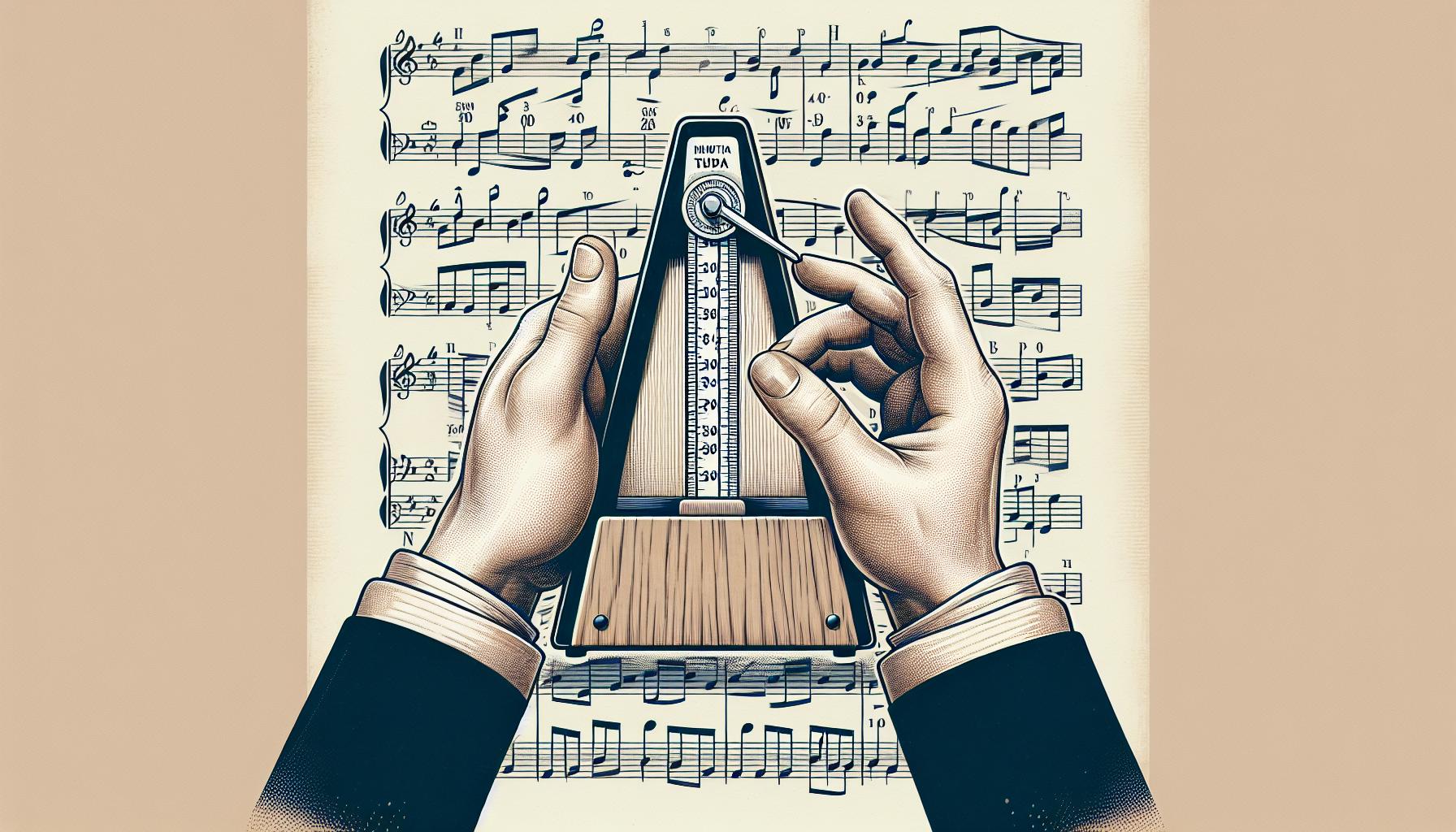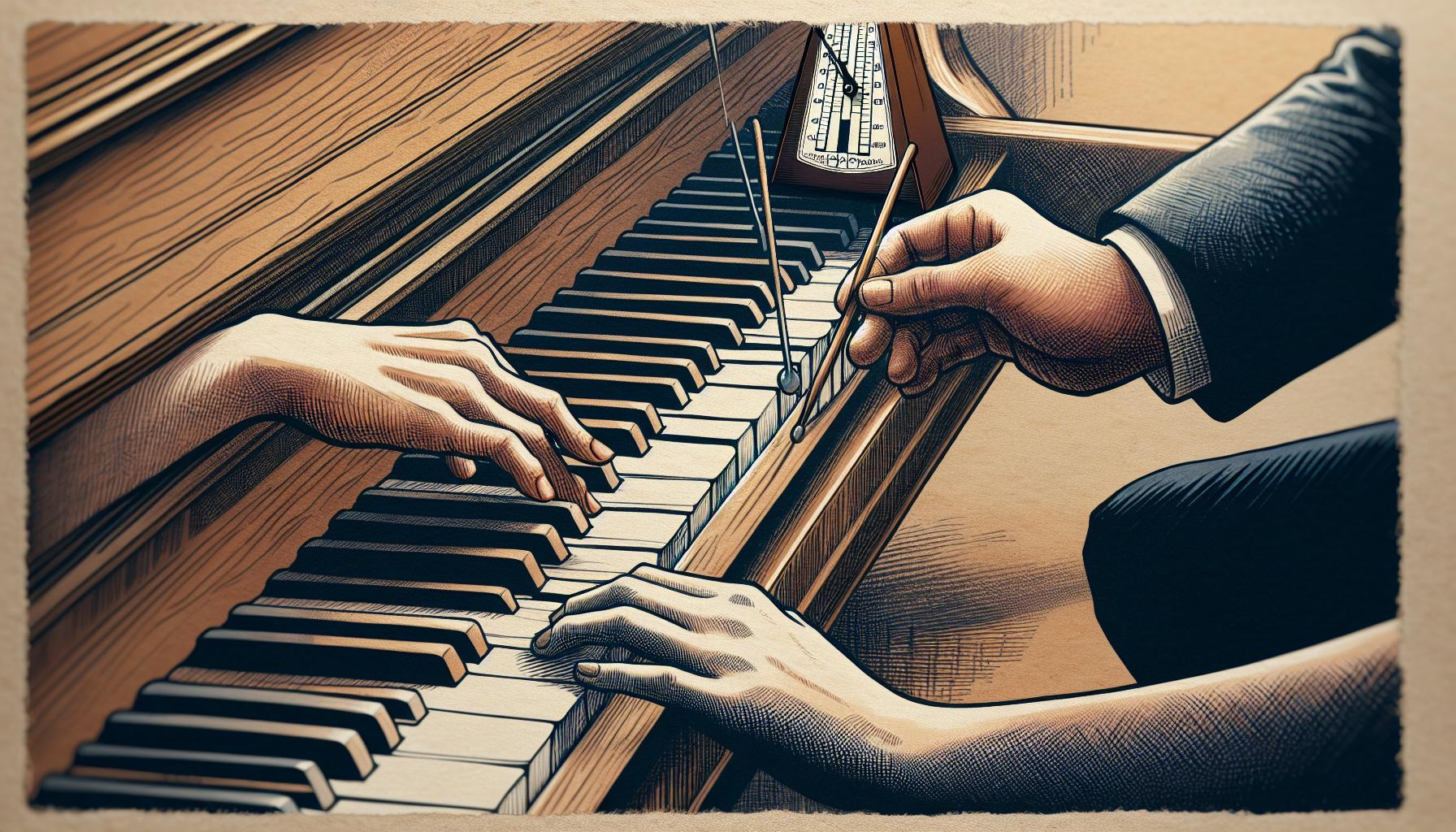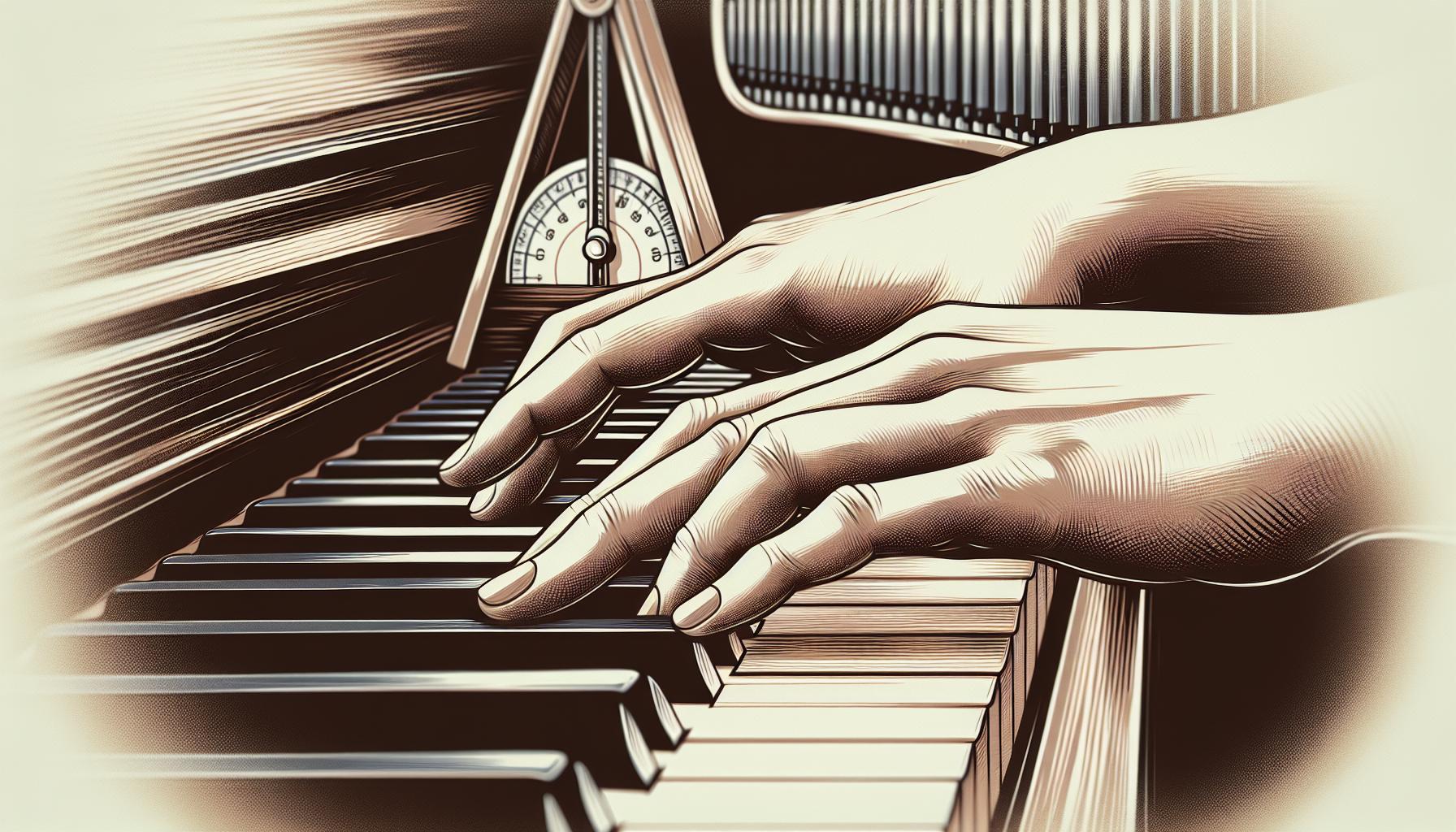Mastering the art of counting rhythms in piano music can transform a good pianist into a great one. It's the backbone of music, giving it structure and emotion. Yet, for many, cracking the code of rhythmic patterns feels like deciphering an ancient language. Fear not, because it's much simpler than it seems at first glance.
Imagine being able to glide through complex pieces, your fingers dancing across the keys in perfect harmony with the beat. That's the power of understanding rhythm. It's not just about hitting the notes but feeling the pulse of the music. This guide is your first step towards achieving rhythmic mastery, making music that doesn't just sound good but feels right.
Understanding Basic Time Signatures
Delving into the world of rhythms in piano music, one cannot overlook the significance of time signatures. They are the roadmap that guides musicians through the timing of each piece, determining the pace and flow of the notes. Understanding time signatures is crucial for any pianist aspiring to master the art of rhythm.
Time signatures are found at the beginning of a piece of music, right after the clef and key signature. They consist of two numbers, one stacked above the other. The top number indicates how many beats are in each measure, while the bottom number reveals what note value is given one beat. The most common time signatures are 4/4, 3/4, and 2/4, though there are many others, each imparting a unique feel to the music.
4/4 Time Signature, often referred to as common time, is the most frequently encountered. In this time signature, there are four beats in each measure, and the quarter note gets one beat. This means that any combination of notes adding up to four quarter notes fits into each measure.
3/4 Time Signature is another widely used time signature, known for its waltz-like rhythm. Each measure has three beats, with the quarter note again being the beat note. This gives the music a distinctive "one-two-three, one-two-three" feel, ideal for dances and ballads.
2/4 Time Signature is simpler, with only two beats per measure. It's often found in march music and is best understood by counting "one-two, one-two." Despite its simplicity, it requires the pianist to maintain a steady tempo to convey the piece's intended energy.
To effectively count rhythms in piano music, pianists should start by tapping the beat with their foot or metronome. For beginners, saying the beats out loud as they play can also be a helpful exercise. It's essential to practice with a variety of time signatures to become comfortable with the feel and pacing of each.
Let's take a look at how different time signatures might appear in music:
| Time Signature | Beats per Measure | Note Given One Beat |
|---|---|---|
| 4/4 | 4 | Quarter Note |
| 3/4 | 3 | Quarter Note |
| 2/4 | 2 | Quarter Note |
Identifying Note Values

Once pianists have a grasp on time signatures, the next crucial step is to understand and master the different note values. In the realm of piano music, each note holds a distinct duration of sound, contributing to the overall rhythm of the piece. Recognizing these different note values is key to effectively counting rhythms.
Note values range from whole notes, which sustain for four beats, to sixteenth notes, which last for a mere quarter of a beat. Each type of note has a specific symbol that musicians can quickly learn to identify. This visual recognition, combined with an understanding of time signatures, enables pianists to decipher how long each note should be held in the context of the music.
- Whole Notes: Sustain for four beats
- Half Notes: Hold for two beats
- Quarter Notes: Last for one beat
- Eighth Notes: Extend for half a beat
- Sixteenth Notes: Maintain for a quarter of a beat
To enhance rhythm counting skills, it’s beneficial for pianists to practice identifying these note values in various pieces of music. By looking at a piece of sheet music and pointing out different note values, they can build a mental map of how the rhythm unfolds.
In addition to standard notes, other symbols like dots and ties affect the duration of a note. A dot placed after a note extends its duration by half of its original value, adding another layer of rhythm complexity. For example, a dotted half note would be held for three beats, adding one more beat to the original two beats of a half note. Ties, on the other hand, connect two notes of the same pitch, effectively lengthening the note’s duration by combining the values of the tied notes.
| Note Type | Symbol | Duration in Beats |
|---|---|---|
| Whole Note | O | 4 |
| Half Note | o- | 2 |
| Quarter Note | ♩ | 1 |
| Eighth Note | ♪ | 0.5 |
| Sixteenth Note | ♫ | 0.25 |
| Dotted Half Note | o-. | 3 (2+1) |
Learning to Count Beats

Learning to count beats in piano music is a foundational skill that all pianists must master. This ability allows players to interpret the rhythm of a piece accurately, thereby ensuring that their performance is both musical and expressive. The process starts with understanding the time signature of a piece, which dictates how many beats are in each measure and what note value constitutes one beat.
Time Signatures: The Basics
Time signatures are notated at the beginning of a piece and consist of two numbers. The top number indicates the number of beats in each measure, while the bottom number reveals the note value that represents one beat. Common time signatures include 4/4, 3/4, and 6/8, each creating unique rhythmic patterns.
- 4/4 Time (Common Time): This time signature means there are four quarter notes per measure.
- 3/4 Time (Waltz Time): Here, each measure contains three quarter notes.
- 6/8 Time: Six eighth notes fill each measure, often creating a lilting rhythm.
The Metronome: A Pianist’s Guide
A metronome is an invaluable tool for pianists learning to count beats. By setting a metronome to a specific tempo, players can practice maintaining a steady beat, which is crucial for rhythmic accuracy. Starting slow and gradually increasing the tempo can help pianists build both confidence and skill in counting beats.
Practicing With Clapping and Counting
Before even sitting down at the piano, musicians can benefit from clapping and counting out rhythms. By clapping the rhythm and speaking the beat aloud, pianists internalize the rhythmic pattern, making it easier to execute when playing. This method also aids in highlighting any syncopation or off-beat rhythms that may be present in the music.
| Note Value | Counting Technique |
|---|---|
| Whole Note | Count 1-2-3-4 |
| Half Note | Count 1-2, 3-4 |
| Quarter Note | Count 1, 2, 3, 4 |
| Eighth Note | Count 1 & 2 & 3 & 4 & |
Practicing Syncopation

Syncopation in piano music can initially seem like a daunting hurdle for learners. When the expected rhythm is disrupted, and emphasis is placed on normally weak beats, the usual flow of the music shifts. But mastering syncopation is not just a challenge; it's an opportunity to bring excitement and variety to piano performances. To tackle this, several strategies can prove immensely helpful.
First and foremost, understanding the concept of syncopation is key. It's when the accent or stress moves from the strong beats to the weaker beats or offbeats. This shift can transform a straightforward rhythm into something more complex and intriguing. To internalize this concept, pianists should start by listening. Finding pieces rich in syncopation and simply listening to them attentively can provide a sense of how syncopation feels and sounds. Jazz and ragtime are genres particularly known for their extensive use of syncopation, offering a wide array of listening options.
Secondly, slow practice is invaluable. When encountering syncopated rhythms, slowing down the tempo allows the pianist to process and understand the placement of each note. They should focus on counting out loud, emphasizing the syncopated beats to ensure accuracy. A metronome is an indispensable tool in this phase, as it provides a steady beat against which the pianist can align the syncopated rhythms.
Here's a useful tip: Clapping out syncopated rhythms before playing them on the piano can bridge the gap between understanding a rhythm intellectually and physically executing it. This method helps in internalizing the rhythm, making it easier for the pianist to replicate it on the instrument.
Incorporating hand independence exercises is also critical when practicing syncopation. Oftentimes, one hand will be playing a steady rhythm while the other hand plays a syncopated pattern. To cultivate this skill, pianists can practice the hands separately at first, gradually bringing them together as they become more confident in their ability to maintain the syncopation.
Finally, repetition plays a fundamental role in mastering syncopation. Through repetitive practice, the initially perplexing rhythms become familiar, eventually feeling as natural as any other rhythm.
- Clap and count out loud syncopated rhythms from sheet music before playing.
- Use a metronome to practice syncopated rhythms at slow speeds, gradually increasing the tempo as confidence grows.
- Listen to recordings of pieces
Applying Rhythmic Techniques to Piano Pieces

Once pianists grasp the basics of rhythm and syncopation, applying these techniques to actual piano pieces becomes the next step. Integrating rhythm into piano music elevates the piece, infusing it with emotion and dynamic movement. It’s all about taking the theory and converting it into practice, which requires patience, focus, and a strategic approach.
The first crucial step is to select pieces that incorporate various rhythmic patterns. This diversity allows pianists to experience firsthand the myriad of ways rhythm can shape music. Choosing pieces with varying levels of difficulty will also help them gradually build their rhythmic abilities. Here’s a suggested approach:
- Start with simple pieces that have a clear and straightforward rhythm.
- Gradually move on to more complex pieces that include syncopation and irregular time signatures.
- Focus on pieces by composers known for their rhythmic complexity, such as Scott Joplin or George Gershwin.
Practicing with a metronome is indispensable. It helps maintain a steady tempo, which is vital when mastering rhythms. Initially, it might feel restrictive, but over time, it teaches the pianist to internalize the tempo, making rhythm more natural and intuitive. The metronome should become a pianist’s steady companion, especially when working through tricky rhythmic passages.
Another effective method is to break down the piece into manageable sections. Tackling a whole piece can feel overwhelming due to its rhythmic complexity. By focusing on small sections, pianists can give each part the attention it needs, mastering it before moving on to the next. This segmented approach ensures a more thorough understanding and execution of the rhythm.
Incorporating rhythm-based exercises into daily practice can also fortify a pianist's rhythmic skills. These exercises might include:
- Clapping out rhythms before playing them on the piano.
- Playing rhythmically challenging sections with each hand separately before combining them.
- Using rhythm software or apps designed to improve rhythmic accuracy and understanding.
Finally, listening and analyzing plays a critical role. Listening to recordings of the pieces being learned, with a particular focus on the rhythm, can provide valuable insights. Pianists should pay attention to how professional musicians navigate rhythmic challenges and try to emulate these techniques. Analyzing the piece's rhythm away from the piano can also offer a new perspective, helping to internalize the rhythm and understand its role within the piece.
Conclusion
Mastering rhythm in piano music is a journey that requires patience, practice, and a keen ear. By adopting the strategies outlined, pianists can elevate their performances, infusing them with the emotion and movement that only rhythm can provide. It’s about more than just hitting the right notes; it's about breathing life into them. So grab those pieces with challenging rhythms, set your metronome, and dive into the world of syncopation and irregular time signatures. Remember, every professional was once a beginner, and with each rhythmic challenge overcome, you're one step closer to mastering the art of piano music. Happy playing!
Harlan Kilstein began playing piano during covid with no piano background at all. He taught himself how to play learning what to do and what not to do.
Today he's an advanced intermediate player and can help you grow in your skills because he learned all this on his own.








